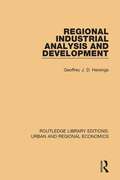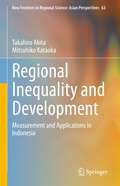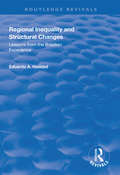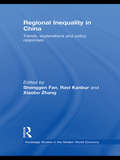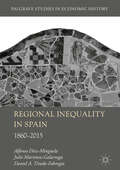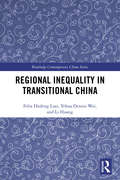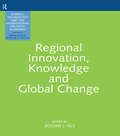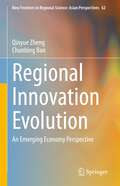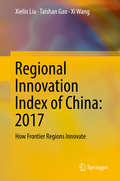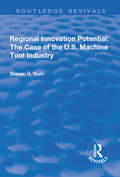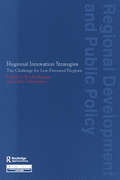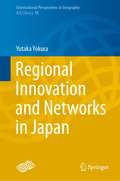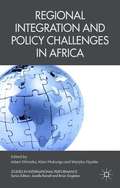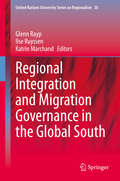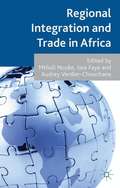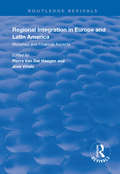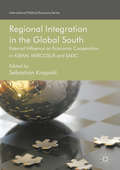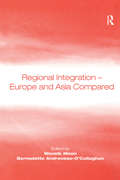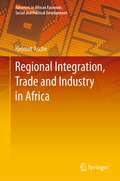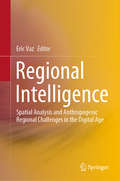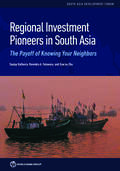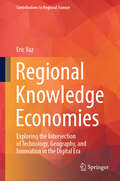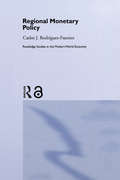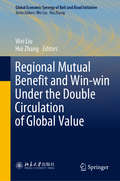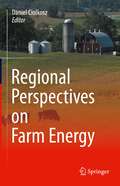- Table View
- List View
Regional Industrial Analysis and Development (Routledge Library Editions: Urban and Regional Economics)
by Geoffrey J. HewingsOriginally published in 1977. This book provides an introduction to some of the more important techniques of regional analysis – techniques derived from geographical, regional economic and regional science theory – and describes the way some of these techniques have been applied in the identification of problems, development of strategy and evaluation of regional programmes. The theory and applications of methods of regional analysis are integrated with the use of examples taken from the USA, the UK and Canada. The author introduces the problems which are encountered in the field of regional analysis, describes some of the analytical tools, beginning with the fundamental model of the economic base approach, and then examines regional flows and the applicability of international trade theory to interregional trade. Considering the shortcomings of the aggregated base approach, input-output analysis is also examined.
Regional Inequality and Development: Measurement and Applications in Indonesia (New Frontiers in Regional Science: Asian Perspectives #63)
by Takahiro Akita Mitsuhiko KataokaThis book addresses three main issues in regional income inequality and development: meaning of regional inequality, measurement of regional inequality and the relationship between national economic development and regional income inequality. It provides analytical methods useful in exploring the determinants of regional inequality in income and productivity. Some software commands in Stata (statistical software package) available for the measurement and analysis of income inequality are also introduced. Some researchers have argued that spatial concentration of population in and around major cities and the concurrent increase in regional inequality do not hinder national economic development, and may stimulate it. Nevertheless, many national governments seek to promote balanced regional economic development and reduce regional income inequality, because unbalanced development and higher levels of regional inequality may cause political or ethnic conflicts between different regions of the country. As the applications of the analytical methods introduced in the first part of the book, the second part presents four independent empirical studies on regional inequality and development in Indonesia. They offer very interesting case studies for the formulation of policies and programs to reduce regional inequalities, because as the world’s largest archipelagic country with more than 13 thousand islands and 300 ethnic groups, Indonesia is spatially diverse in terms of its ecology, natural resource endowments, economy, ethnicity and culture.This book can be used as a textbook for undergraduate and graduate students who are interested in national economic development and regional income inequality. It is also beneficial for practitioners and policy makers who are in charge of the formulation, implementation and evaluation of development policies and programs.
Regional Inequality and Structural Changes: Lessons from the Brazilian Experience (Routledge Revivals)
by Eduardo A. HaddadPublished in 1999. The liberalization process in Latin America during the 1990s resulted in the increase and diversification of trade in the region. Brazil, as a major player, strengthened its insertion into the world economy through the adoption of strategies for opening up markets and of new production technologies; complemented more recently by the creation of a broadly based stabilization plan. In this context, issues related to structural changes in the economy, such as those involving the complexity of new international trading agreements and their impact on the Brazilian economy, warrant special attention. The results of this study suggest that the interplay of market forces in the Brazilian economy favour the more developed region of the country.
Regional Inequality in China: Trends, Explanations and Policy Responses (Routledge Studies in the Modern World Economy)
by Ravi Kanbur Xiaobo Zhang Shenggen FanChina’s spectacular growth and poverty reduction has been accompanied by growing inequality which threatens the social compact and thus the political basis for economic growth. Chinese policy makers have realized the importance of the problem and have launched a series of investigations and policy initiatives to address the issues. The regional dimension of inequality—rural/urban and inland/coastal—dominates in a country as large as China, and especially with its particular history. Not surprisingly, regional inequality has come to loom large in the policy debate in China. The policy debate has been informed by, and to some extent instigated by, a parallel analytical literature which has quantified the magnitude of the problem and identified recent trends, offered explanations based on rigorous analysis, and proposed policy interventions in light of the facts and understanding. Through a series of articles which have been published in leading journals, the editors have been involved in a systematic investigation into the nature and evolution of regional inequality in China for over a decade.
Regional Inequality in Spain: 1860-2015 (Palgrave Studies in Economic History)
by Alfonso Díez-Minguela Julio Martinez-Galarraga Daniel A. Tirado-FabregatThis book traces regional income inequality in Spain during the transition from a pre-industrial society to a modern economy, using the Spanish case to shed further light on the challenges that emerging economies are facing today. Regional inequality is currently one of the most pressing problems in the European Union, and this text presents a novel dataset covering 150 years to analyse long-run trends in regional per capita GDP.
Regional Inequality in Transitional China (Routledge Contemporary China Series)
by Yehua Dennis Wei Felix Haifeng Liao Li HuangThis book investigates uneven regional development in China – with particular focus on the cases of Guangdong and Zheijiang provinces – which have been at the forefront of debate since Chinese economic reform. Rapid economic growth since the ‘opening-up’ of China has been accompanied by significant disparities in the regional distribution of income: this book represents one of the most recent studies to present a picture of this inequality. Built upon a multi-scale and multi-mechanism framework, it provides systematic examination of both the patterns and mechanisms of regional development and inequality in provincial China, emphasizing the effects of economic transition. Approaching from a geographical perspective, its authors consider the interplay between the local, the state, and the global forces in shaping the landscape of regional inequality in China. Extensive empirical findings will prove useful to those researching other developing countries within the frontier of globalization and economic transition. Regional Inequality in Transitional China will appeal to scholars and students of geography, economics and Chinese studies more broadly.
Regional Innovation And Global
by Zoltan AcsFirst Published in 1999. Routledge is an imprint of Taylor & Francis, an informa company.
Regional Innovation Evolution: An Emerging Economy Perspective (New Frontiers in Regional Science: Asian Perspectives #62)
by Chunbing Bao Qinyue ZhengThis book covers many aspects of innovation theory, evolutionary economics, economic geography, and simulation models. It is one of the first books to comprehensively and systematically focus on the evolution of regional innovation based on provincial experience in emerging economics, including stylized facts, theoretical explanation, and simulation. The book is devoted to a pioneering process-based regional innovation matrix used for classifying a regional innovation model, which is illustrated by real-world cases and data analyses. The topics addressed here include path dependency, lock-in, routines, variations, selectivity, regional gap, innovation progress, agglomeration, and innovation efficiency. The simulation methods describing the dynamics of regional innovation evaluation on economics are developed as well. The primary objective of this work is to provide a tractable and useful regional governance tool for researchers and policy makers in regional science, human geography, and related disciplines. The book is highly recommended to readers who seek more insight into the continuous development of China or regional development gaps.
Regional Innovation Index of China: How Frontier Regions Innovate
by Xielin Liu Taishan Gao Xi WangThe book aims to explore the regional innovation capability of China, especially how the frontier regions of China (Guangdong, Jiangsu, Beijing, Shanghai, Zhejiang and Tianjin) transform themselves from an investment-driven economy into an innovation-driven one. With detailed case, data and policy, we analyse the modes of each province and municipality from different perspectives such as comparative advantage in innovation, existing industrial base and culture, the government’s innovation strategy, and industrial upgrading pattern.
Regional Innovation Potential: The Case Of The U. S. Machine Tool Industry (Routledge Revivals Ser.)
by Steven R. NivinThis title was first published in 2000: Steven Nivin analyzes a process vital to economic development - technological change. He furthers understanding of the processes driving innovation, so that we may gain a deeper insight into the development of economies. Specifically, the study explores the concept of innovation potential and the factors that result in variations in innovation potential across metropolitan areas, using the US machine tool industry as a case study. To provide a comparison, the same models are also estimated for the semiconductor industry. The findings indicate that urbanisation economies, localization economies, human capital, universities, and invention-derived knowledge are significant factors. The study assesses the contributions of three different skill levels of human capital; college-educated, graduate degree, and locally produced PhD’s in mechanical and electrical engineering. Only the graduate and PhD degree measures are found to be significant, indicating the importance of having a highly skilled pool of labour within the region. The influences of the factors appear to be similar across industries, with some slight differences. The transfer of knowledge through patents is also studied. It is found that the transmission of this knowledge is slower between different industries, relative to the transmission within the same industry.
Regional Innovation Strategies: The Challenge for Less-Favoured Regions (Regions and Cities #Vol. 24)
by Kevin Morgan Claire NauwelaersRegional Innovation Strategiesoffers the first comprehensive analysis of the new wave of innovation-oriented regional policies. It draws conclusions from the European Regional Technology Plans and Regional Innovation Strategies, both in old industrialised areas and in regions where development is slow, and compares this with US and Canadian experiences. Anticipating the enlargement of the EU, Regional Innovation Strategies also assesses the growing interest in the subject within policy, academic and practitioner circles in Central and Eastern European countries. This book aims to provide information on the new regional innovation polices and gives the first assessment of this promising pool of regional experiences.
Regional Innovation and Networks in Japan (International Perspectives in Geography #16)
by Yutaka YokuraThis book provides a novel perspective on networks and innovation in the field of economic geography and presents new findings through theoretical foundations and empirical analyses. The book focuses on various temporary systems in industrial agglomerations such as joint R&D, trade fairs, business workshops, and international conferences. Following the introduction, Chapter 2 considers the mechanism of the innovation process in which networks function as institutions. Chapter 3 and succeeding chapters conduct empirical research centered on statistical data analysis such as social network analysis and covariance structure analysis, and they determine the real-world situations through interview surveys of related stakeholders. Chapter 3 considers the structure and spatial patterns of R&D networks in Japan by making the structure visible and calculating network indices. Chapter 4 concentrates on local trade fairs held in industrial agglomerations and examines the development of various relationships between related participants. Chapters 5 and 6 shed light on institutional thickness in industrial agglomerations. Chapter 7 spotlights quantitative and metrical examinations of inter-organizational relationships in terms of knowledge flows based on company-level data regarding technological alliances and ownership relationships between global corporations. The studies featured in Chapters 6 and 7 serve to evaluate how Japan’s firms have adapted to radical changes under global competition.
Regional Integration And Policy Challenges In Africa
by Adam B. Elhiraika Allan C. K. Mukungu Wanjiku NyoikeThe role of integration as a catalyst for economic growth, development and insulation from global shocks has made the concept of regional integration even more attractive to states. This books contains compelling arguments and empirical observations that detail some of the key opportunities governments in Africa are pursuing.
Regional Integration and Migration Governance in the Global South (United Nations University Series on Regionalism #20)
by Glenn Rayp Ilse Ruyssen Katrin MarchandThis topical volume deals with the major challenges of migration in the Global South and their governance, which are traditionally much less considered than migration to industrialized countries and its consequences. It is written in view of the intergovernmental agreement of the Global Compact for Safe, Orderly and Regular Migration, negotiated under the auspices of the United Nations in 2016, and one of the major recent events in international migration governance. Written by authors with a sound academic background and professional involvement in policy relevant research, this volume focuses on priorities in implementation of the Global Compact in the Global South. It is addressed to a broad readership interested or involved in international migration governance, development studies, and regional studies, from a research as well as a policy perspective.
Regional Integration and Trade in Africa
by Mthuli Ncube Issa Faye Audrey Verdier-ChouchaneThis book reviews the current trends and challenges of regional integration and trade in Africa. It provides valuable policy recommendations aimed at stimulating the debate among the government, private sector and development community on the ways to promote regional trade for Africa's economic development.
Regional Integration in Europe and Latin America: Monetary and Financial Aspects (Routledge Revivals)
by Pierre van HaegenOriginally published in 2004. This comprehensive collection provides an innovative analysis and a comparison between economic and financial integration in Europe and Latin America, addressed from a global, regional and country-specific perspective. It constitutes a valuable overview focusing on three topics: regional integration and monetary cooperation in Europe and Latin America, exchange rate strategies and financial sector structure. The collection is the outcome of a Workshop and high-level Seminar organized by the Banco de España and the European Central Bank that brought together senior European and Latin American central bankers, as well as senior representatives from international institutions. The 31 contributors presented high quality papers, allowing the reader to take advantage of a rigorous economic analysis that uses first-hand information and draws useful lessons for the future.
Regional Integration in the Global South
by Sebastian KrapohlThis book presents a theory of economic integration in developing regions, where the level of intraregional economic interdependence is low and the dependence on extra-regional economic relations is high. It argues that the success or failure of regional integration in the Global South is to a large degree dependent on the reaction of extra-regional actors in Europe, North America and Northeast Asia. In doing so, it demonstrates that longstanding European integration theories cannot be successfully applied to other world regions, where economic conditions are fundamentally different. By providing detailed empirical analyses that are systematic in their use of a common theoretical and methodological framework the authors fill a significant lacuna in our understanding of these issues. This edited volume will appeal to students and scholars of comparative regionalism, area studies and global governance.
Regional Integration – Europe and Asia Compared
by Woosik MoonThe aim of this book is to examine and compare the integration process in both Europe and Asia, and to draw some possible lessons for East Asia from the European experience, which culminated with the establishment of the economic and monetary union. The book embraces the political dimension of integration (peace and security), economic, trade and monetary aspects, and cultural aspects. Written by well-known experts in the field of integration, this book represents one of the first attempts at comparing Europe and Asia in the process of integration, by incorporating the latest developments in the field. The main theme of the book - integration in Asia from a comparative perspective - has been relatively unexplored as most experts in the field of integration are also 'area experts' (i.e. European integration experts or Asian experts). The contributors to the book provide a distinctive perspective based upon their understanding of integration (political, economic, and socio-cultural) across various regions of the world.
Regional Integration, Trade and Industry in Africa (Advances in African Economic, Social and Political Development)
by Helmut AscheThis book examines the past, present and prospects of regional economic integration in Africa. The empirical analysis ranges from unions formed during the years following independence, to the proposed African Continental Free Trade Area (AfCFTA), which aims to remove trade barriers between all 55 African states. In addition, the book explores to what extent Africa’s Regional Economic Communities (RECs) have advanced in accordance with a linear integration model of goods, labor and capital markets.The book subsequently evaluates the suitability of the European model of deep integration with costly institutions for the conditions specific to Africa, considering, for example, the role of informal and non-recorded trade. Stylized cases of regional division of labour with increasing returns and imperfect competition are introduced to support the economic integration logic. Past and current economic policies in Africa are scrutinized to answer the question: how can African regions best foster new manufacturing industries and value chains across the continent? In conclusion, the book outlines content and processes of Common Industrial Policy in the African regions. The book also addresses the controversial issue of international trade agreements between developing countries and the European Union or the USA and investigates whether these agreements impede or promote economic development in Africa. The book includes a detailed roadmap describing how to improve key clauses of agreements for economic partnership in the interest of African countries. In closing, it outlines a new vision of joint sustainable development for Africa and Europe.
Regional Intelligence: Spatial Analysis and Anthropogenic Regional Challenges in the Digital Age
by Eric VazRegional Intelligence is an emerging field that leverages the lessons learned through decades of regional science. By merging spatial analysis with quantitative analytical techniques in the Anthropocene, this book contributes to the multidisciplinary understanding of regional issues. The locational aspects of regional paradigms are explored through various empirical studies that promote a rich and diversified understanding of regional issues concerning policy, governance, land use, and territorial decisions. Given its scope, the book will appeal to scholars and students of regional and spatial sciences and geography, as well as practitioners and decision makers engaged in regional planning and policymaking, looking for new methodological approaches that offer insights into sustainable development, regional prosperity, and livability. As a unique contribution, this book challenges the status quo on how complex spatial problems at an international level and at multiple scales can be comprehended.
Regional Investment Pioneers in South Asia: The Payoff of Knowing Your Neighbors (South Asia Development Forum)
by Sanjay Kathuria Ravindra A. Yatawara Xiao’ou ZhuRegional economic engagement within South Asia may gain increasing importance owing to several factors that are currently in play, including strategies to diversify global value chains and locate such value chains nearer home. These developments offer South Asia a chance to enhance its low levels of regional economic engagement and capitalize on significant unrealized development opportunities. This report shows that examining intraregional investment and knowledge connectivity enhances our understanding of the low levels of intraregional trade and limited regional value chains in South Asia. Creating a new and unique data set for South Asian investment, it provides a detailed and nuanced understanding of the drivers of outward investment, both regional and global, for South Asian firms. “Regional Investment Pioneers in South Asia†? provides key considerations for policy makers in South Asia, which remain particularly relevant in the aftermath of the pandemic. First, it makes a case for regulatory relaxation of outward FDI regimes, based on new micro foundations, grounded in value chains. Second, it spells out details of smart inward FDI promotion techniques and investment facilitation. Third, it identifies distinct cross-border information-enhancing and network development activities. Fourth, it suggests that digital connectivity and continued interventions in reducing trade costs are warranted to increase investment as well as trade flows. There is particular scope to build on the digitalization initiatives in trade and investment facilitation taken during the pandemic. “Regional Investment Pioneers in South Asia†? follows on, and is complementary to, the earlier World Bank report, “A Glass Half Full: the Promise of Regional Trade in South Asia.†?
Regional Knowledge Economies: Exploring the Intersection of Technology, Geography, and Innovation in the Digital Era (Contributions to Regional Science)
by Eric VazThis book investigates the multifaceted relationships between knowledge structures, technology, geography, and regional science. This includes a scholarly exploration of the role of geographical proximity in knowledge structures (spatial spillovers), the transformative potential of the metaverse in knowledge management, and the historical and cultural influences on modern knowledge ecosystems. It further scrutinizes the impact of technology on knowledge distribution, the guiding role of institutions and organizations in knowledge societies, and the value of cultural diversity for cross-cultural knowledge exchange. Addressing complex ethical, privacy, and accessibility challenges, the book concludes by offering strategic insights for creating sustainable knowledge ecosystems, making it an invaluable resource for researchers and professionals in the intersecting domains of technology, geography, regional science, and beyond.
Regional Monetary Policy (Routledge Studies in the Modern World Economy)
by Carlos Javier Rodriguez FuentesWith the final phase of the European Monetary Union underway, concern has been raised over the regional implications of the European Central Bank (ECB) Monetary Policy. Departing from the standard approach utilized by the ECB, this book provides a comprehensive theoretical framework to explore the ways through which money and monetary policy may affect regions. Carlos Rodriguez Fuentes, the rising star of Spanish economics, has produced a work of impressive clarity which analyzes the effects of regional monetary policy - with particular reference to European Monetary Union. Here, he examines the role that the banking system and the liquidity preference of economic agents play in the transmission of central banks monetary policy decisions to regions within a country or countries within a currency union. Rodriguez Fuentes utilizes a unique framework built upon the basic principle of the Post-Keynsian monetary theory which enables the identification of a new way for money and monetary policy to have a regional impact; the behavioural effect. This book, with it’s combination of literary and empirical approach will prove essential reading for all students of economics and politics, as well as readers who interested in the development of the European Union.
Regional Mutual Benefit and Win-win Under the Double Circulation of Global Value (Global Economic Synergy of Belt and Road Initiative)
by Wei Liu Hui ZhangThe book offers an in-depth research of the economic situations along the Belt and Road and the initiative’s cooperation prospects, opportunities and challenges. It draws on economic data, including those on trade, investment, infrastructure, urban distribution, industrial cooperation, financial integration and revision of historical and political background. The Belt and Road initiative (BRI) comes from not only the ancient Silk Road, but also a long-term international cooperation between China and relevant countries. As a China-led initiative, the BRI is built upon China’s international vision according to its development process. Therefore, the book also discusses how China balances its own development process among different domestic regions, and how the Initiative fits into the changes of global economic system and brings positive change for developing and developed economies involved, on the long haul. Furthermore, this book aims to find out precise direction of the initiative in order to assess appropriate implication on development under current globalization and provide valuable experience for future economic synergetic development by reviewing the past cooperative experience as references for policy-making and prospective engagementIn terms of methodology, analyses were conducted applying multi-methods with best available evidence to enrich the understanding of the potential of the BRI in terms of socio-economic impact on cooperation and difference and similarities of economic, cultural characteristics and political system among countries.
Regional Perspectives on Farm Energy
by Daniel CiolkoszThis book examines the characteristics and opportunities for farm energy in the northeast quadrant of the United States, with attention to energy use, strategic energy management, and energy production by solar, wind, biomass, and other means. Throughout, the distinct characteristics of the region and their impact on energy solutions are discussed, and the outlook for future energy strategies is considered. Farm energy production and use are topics of increasing interest, as the need for improved efficiency and the opportunity for sustainable energy production both drive agricultural enterprises to reduce energy use and pursue opportunities for renewable energy production and use on the farm. However, the unique regional characteristics of agriculture make it challenging to apply a single approach to all situations.
